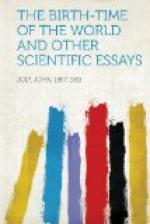[1] Weismann, Life and Death; Biological Memoirs, p. 146.
[2] In connection with the predestinating power and possible complexity of the germ, it is instructive to reflect on the very great molecular population of even the smallest spores—giving rise to very simple forms. Thus, the spores of the unicellular Schizomycetes are estimated to dimensions as low as 1/10,000 of a millimetre in diameter (Cornil et Babes, Les Batteries, 1. 37). From Lord Kelvin’s estimate of the number of molecules in water, comprised within the length of a wave-length of yellow light (The Size of Atoms, Proc. R. I., vol. x., p. 185) it is probable that such spores contain some 500,000 molecules, while one hundred molecules range along a diameter.
97
THE NUMERICAL ABUNDANCE OF LIFE
We began by seeking in various manifestations of life a dynamic principle sufficiently comprehensive to embrace its very various phenomena. This, to all appearance, found, we have been led to regard life, to a great extent, as a periodic dynamic phenomenon. Fundamentally, in that characteristic of the contrivance, which leads it to respond favourably to transfer of energy, its enormous extension is due. It is probable that to its instability its numerical abundance is to be traced—for this, necessitating the continual supply of all the parts already formed, renders large, undifferentiated growth, incompatible with the limited supplies of the environment. These are fundamental conditions of abundant life upon the Earth.
Although we recognise in the instability of living systems the underlying reason for their numerical abundance, secondary evolutionary causes are at work. The most important of these is the self-favouring nature of the phenomenon of reproduction. Thus there is a tendency not only to favour reproductiveness, but early reproductiveness, in the form of one prolific reproductive.
98
act, after which the individual dies.[1] Hence the wavelength of the species diminishes, reproduction is more frequent, and correspondingly greater numbers come and go in an interval of time.




